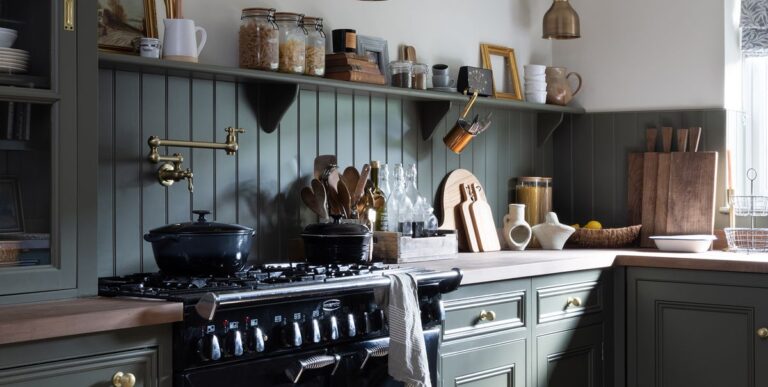We're all used to filling our homes with antiques and second-hand furniture, and we're well aware of the costs and environmental benefits of doing so.
But second-hand kitchens are a different story. We all want a brand new kitchen with a pristine stove and shiny cabinets, right? Of course. But second-hand kitchens are becoming more and more popular, and they might not be what you'd expect.
There are a growing number of retailers specialising in selling second-hand kitchens, says Daniel Abrahams, founder of Used Kitchen Hub. Country life We'll discuss the myriad benefits of buying second-hand and four things to consider before you buy.
“Buying second-hand kitchens is becoming a more prominent trend as homeowners prioritize eco-friendly habits and look to reduce their carbon footprint,” Daniel says.
“This is driven not only by environmental concerns but also by economic considerations, with people looking for cost-effective alternatives to traditional kitchen renovations.”
If you browse websites like Used Kitchen Hub, you'll see kitchens photographed on-site and a breakdown of the units included, their size and condition, as well as details of appliances such as wine fridges and cookers that are often included.
But the process of buying a used kitchen is something of an exercise in creativity and resourcefulness.
The possibilities for reconfiguration are nearly endless: individual materials such as marble countertops and wooden fronts may be repurposed or cut to size to suit your home. Kitchen islands and sideboards may even be available separately, or a refurbished Quooker tap may be offered at a deep discount.
“Some people may be concerned about the durability of a second-hand kitchen, but it's important to dispel the misconception that a second-hand kitchen is less durable than a new one,” says Daniel. “In fact, many second-hand kitchens have been meticulously maintained and have superior craftsmanship, making them just as durable as a new one.”
Benefits of buying a used kitchen
Cost Savings: Used kitchens are significantly more affordable than new ones, making them a great way to save money without compromising quality. “This affordability not only makes kitchen upgrades more accessible to a wider range of people, but it also allows homeowners to consider luxury options that may have previously been beyond their budget,” says Daniel.
sustainability: Buying second-hand helps prevent perfectly functional kitchens from ending up in landfill: “Research has shown that buying a second-hand kitchen can significantly reduce landfill waste and the carbon emissions associated with manufacturing and disposal. Buying a second-hand kitchen saves around five tonnes of carbon.”
Higher quality materials: Used kitchens are often made from premium materials to ensure durability and resilience, and it's not uncommon to find premium kitchen brands such as deVOL, Bulthaup, and Harrison Collier.
Faster Delivery: Unlike new kitchens that require assembly, pre-owned kitchens are delivered quickly and ready to be installed.
Daniel's tips for buying second hand:
1. Make sure you get what you pay for
“When buying second-hand, checking the quality is paramount. A brand new kitchen is guaranteed to be new, but when buying second-hand, attention to detail is key. The integrity of the construction, the quality of materials and the functionality of the appliances are key factors in the inspection process,” says Daniel.
“Reliable dealers play a key role in facilitating this process by providing assurance through rigorous inspections and transparent disclosure of any issues or defects.”
2. You don't have to stick to the configuration you bought
“One of the most appealing things about buying a used kitchen is the ability to customize and adapt it to your personal tastes,” says Daniel. “From reconfiguring the layout to refinishing cabinets and replacing fixtures, there are plenty of ways to breathe new life into a used kitchen and make it your own.”
If you're customising a used kitchen, save money by using off-cut worktops and higher-grade appliances, and look for alternative sources for materials and accessories, such as lumber yards, car boot spaces and online marketplaces.
3. Find a demonstration kitchen
While second-hand kitchens typically come from private homes, display kitchens are ostensibly unused kitchens that have been used in a showroom, store or photo shoot. “Most display kitchens in particular come with a full set of appliances, are unused and often still under warranty,” says Daniel.
4. Consider resale value
“One of the most attractive things about buying a used kitchen is the cost savings it can bring,” says Daniel. “Plus, the resale value of used kitchens tends to be relatively high, meaning homeowners may be able to sell it again in the future if necessary.”
Rachel Edwards is the Style & Interiors Editor for Country Living and House Beautiful, covering all things design and decor. She is particularly interested in small space inspiration, vintage and antique shopping, and all things colour. Her work has been widely translated by Elle Japan and Elle Decor Spain. Rachel has worked in the furniture and homewares industry for over 10 years as a writer, FF&E designer and as the long-time Marketing Manager at cult design retailer Scandium. She holds a BA in French and Italian from Royal Holloway and an MA in Journalism from Kingston University. Follow Rachel on Instagram @rachelaed






